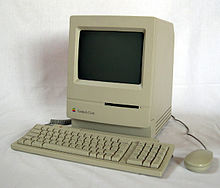 Macintosh Classic | |
| Also known as | "XO"[1] |
|---|---|
| Manufacturer | Apple Computer |
| Product family | Compact Macintosh |
| Type | All-in-one |
| Release date | October 15, 1990[2] |
| Introductory price | US$999 (equivalent to $2,330 in 2023) with 40 MB hard disk and 2 MB RAM: US$1,499 (equivalent to $3,500 in 2023) |
| Discontinued | September 14, 1992[2] |
| Operating system | |
| CPU | Motorola 68000 8 MHz[2] |
| Memory | 1 MB, expandable to 4 MB (requires a RAM card); 120 ns, 30-pin DRAM chips required[1] |
| Display | 9 in (23 cm) monochrome, 512 × 342 |
| Dimensions |
|
| Mass | 16 lb (7.3 kg) |
| Predecessor | |
| Successor | Macintosh Classic II |
| Related | Macintosh IIsi Macintosh IIci Macintosh IIfx Macintosh LC Macintosh Portable |
The Macintosh Classic is a personal computer designed, manufactured and sold by Apple Computer from October 1990 to September 1992. It was the first Macintosh to sell for less than US$1,000.[3]
Production of the Classic was prompted by the success of the original Macintosh 128K, then the Macintosh Plus, and finally the Macintosh SE. The system specifications of the Classic are very similar to those of its predecessors, with the same 9-inch (23 cm) monochrome CRT display, 512 × 342 pixel resolution, and 4 megabyte (MB) memory limit of the older Macintosh computers.[2] Apple's decision to not update the Classic with newer technology such as a newer CPU, higher RAM capacity or color display resulted in criticism from reviewers, with Macworld describing it as having "nothing to gloat about beyond its low price"[4] and "unexceptional".[5] However, it ensured compatibility with the Mac's by-then healthy software base, as well as enabled it to sell for the lower price, as planned. The Classic also featured several improvements over the aging Macintosh Plus, which it replaced as Apple's low-end Mac computer. It is up to 25 percent faster than the Plus[1] and included an Apple SuperDrive 3.5-inch (9 cm) floppy disk drive as standard. Unlike the Macintosh SE/30 and other compact Macs before it, the Classic did not have an internal Processor Direct Slot, making it the first non-expandable desktop Macintosh since the Macintosh Plus. Instead, it had a memory expansion slot.
The Classic is an adaptation of Jerry Manock's and Terry Oyama's 1984 Macintosh 128K industrial design, as had been the earlier Macintosh SE. Apple released two versions. The price and the availability of education software led to the Classic's popularity in education. It was sold alongside the more powerful Macintosh Classic II in 1991 until its discontinuation the next year.
- ^ a b c Pogue, David; Schorr, Joseph (1999). MacWorld Mac Secrets, 5th Edition. IDG Books. pp. 462–463. ISBN 0-7645-4040-8.
- ^ a b c d e "Macintosh Classic: Technical Specifications". support.apple.com. July 26, 2017. Archived from the original on June 12, 2013. Retrieved September 13, 2022.
- ^ Ould, Andrew (August 6, 1990). "Mac Classic to debut at under $1,000". PC Week. p. 17.
- ^ Poole, Lon (December 1990). "The Macintosh Family Evolves". MacWorld Magazine. pp. 188–175.
- ^ Poole, Lon (December 1990). "Review – Mac Classic". MacWorld Magazine: 176–179.